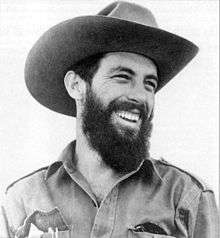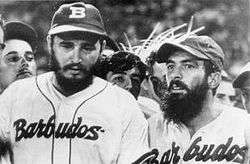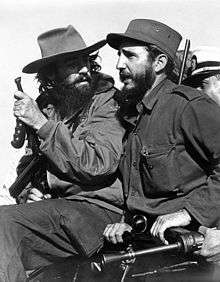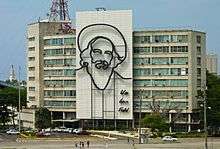Camilo Cienfuegos
| Camilo Cienfuegos | |
|---|---|
 | |
| Born |
Camilo Cienfuegos Gorriarán 6 February 1932 Lawton, Havana, Cuba |
| Died |
28 October 1959 (aged 27) Cuba Florida Straits |
| Nationality | Cuban |
| Organization | 26th of July Movement |
Camilo Cienfuegos Gorriarán (Spanish: [kaˈmilo sjeɱˈfweɣoz ɣorjaˈɾan]; 6 February 1932 – 28 October 1959) was a Cuban revolutionary born in Havana. Along with Fidel Castro, Che Guevara, Juan Almeida Bosque, and Raúl Castro, he was a member of the 1956 Granma expedition, which launched Fidel Castro's armed insurgency against the government of Cuban dictator Fulgencio Batista. He became one of Castro's top guerilla commanders, known as the "Hero of Yaguajay" after winning a key battle of the Cuban Revolution.
He was appointed head of Cuba's armed forces shortly after the victory of Castro's rebel army in 1959. He was presumed dead when a small plane he was traveling in disappeared during a night flight from Camagüey to Havana later that year. Cienfuegos is revered in Cuba as a hero of the Revolution, with monuments, memorials, and an annual celebration in his honor.
Early life
Camilo Cienfuegos was born on 6 February 1932, in Havana's Lawton district. He was raised in a working-class family that had emigrated from Spain prior to the Spanish Civil War. His father, a tailor who worked a small shop in Havana, had left-wing political principles.[1]
Artistically inclined since early youth, Camilo enrolled in the Escuela Nacional de Bellas Artes "San Alejandro" in 1950, but left his studies soon after due to financial problems. During this period he started working as a tailor apprentice in the "El Arte" fashion store in downtown Havana.
Around 1948 he became involved in political issues, taking part in popular protests against rising bus fares. In April 1953, Cienfuegos and a friend traveled to the U.S. on 29-day visitors' visas in search of work. They spent several months working low-paying jobs in New York City, Chicago, and San Francisco until they were taken into custody by immigration officials and returned to Cuba via Mexico. While in New York Cienfuegos became involved with a Cuban political exile group and wrote a few articles for its newspaper, La Voz de Cuba.[2]
In personality, writes one historian, Cienfuegos "exemplified the quintessential native, male, urban Cuban with his sense of humor, great interest in dancing and baseball, good looks, love of women, and overall joie de vivre".[1] Rufo López-Fresquet, who served as Minister of the Treasury for the first fourteen months of the revolutionary regime, described him as "a gay, happy-go-lucky, adventuresome sort".[3][4]
Political awakening
In 1954 Cienfuegos became an active member of the underground student movement against autocratic President Fulgencio Batista. On 5 December 1955, the eve of the anniversary of the death of 19th-century Cuban independence hero Antonio Maceo, Cienfuegos and other students were shot and wounded in Havana while returning to the university after placing a wreath on Maceo's monument.[5] He later described this as the moment in which he pledged himself to freeing Cuba from the Batista dictatorship. Jobless and harassed by police, he left Cuba in March 1956 and again travelled to the US, where he worked in Miami and San Francisco for a few weeks before heading to Mexico, intent on joining a small Cuban rebel army being organized by Fidel Castro.[2] On arriving in Mexico, Cienfuegos befriended Castro and began training with the rebels. He was one of the 82 revolutionaries who set sail for Cuba aboard the Granma in November 1956. Allegedly, Cienfuegos was the last one to board the boat and was only allowed to join because of his slight build.

Cienfuegos was not as "politically sophisticated" as the Castros or Guevara,[1] and has been described as "ideologically an unknown quantity".[4] He "sympathized with socialism",[6] but was not particularly dogmatic.[7] On the question of tactics, he departed from many others in the revolutionary movement in rejecting violence and revenge. In October 1958, when a Cuban Masonic organization expressed concern that someone captured by the rebels might be tortured and killed, he replied:[8]
Your petition is unnecessary, because under no condition would we put ourselves at the same moral level as those we are fighting.... We cannot torture and assassinate prisoners in the manner of our opponents; we cannot as men of honor and as dignified Cubans use the low and undignified procedures that our opponents use against us. The spirit of nobility and chivalry inculcated in each one of our soldiers, with respect for prisoners and for the military, is the reason why more than seven hundred of them, after twenty-three months of struggle against the tyranny, find themselves today in the bosom of their families.
Guerrilla activities

The Granma arrived in Cuba on 2 December. After a three-day nightmare of swamps and mangroves, the rebels were surprised by Batista's forces at Alegría de Pío. The surviving rebels escaped in small dispersed groups and wandered for weeks in the Sierra Maestra mountains. Cienfuegos was one of the twelve who survived to rejoin Castro a month later.
In 1957 he became one of the top leaders of the revolutionary forces, appointed to the rank of Comandante. In 1958, with the defeat of Operation Verano, Cienfuegos was put in command of one of three columns which headed west out of the mountains with the intention of capturing the provincial capital city of Santa Clara. Che Guevara was in command of another column and Jaime Vega was in command of the third. Vega's column was ambushed and defeated by Batista's forces.
Cienfuegos' and Guevara's columns reached the central provinces, where they combined their efforts with several other groups. Cienfuegos' column attacked an army outpost at Yaguajay and, after a tough fight, forced the garrison to surrender on 30 December 1958. This earned him the nickname "The Hero of Yaguajay". Cienfuegos' column then advanced against Santa Clara in conjunction with Guevara's forces, and the other non-Castro forces from the Escambray front. Together, the two columns captured Santa Clara on 31 December. Most of the defenders surrendered without firing their weapons. Batista fled Cuba the next day, leaving the guerrilla fighters victorious.[9] At a rally on 8 January 1959, Castro interrupted his speech to ask Cienfuegos "¿Voy bien, Camilo?" (Am I doing all right, Camilo?) His response "Vas bien, Fidel" (You're doing fine, Fidel) was taken up by the crowd and became a slogan of the revolution.[10]
For the next several months, Cienfuegos served as Chief of Staff of the Cuban Army, helped defeat several anti-Castro uprisings, and played a role in implementing the regime's agrarian reforms.[11]
Death
Huber Matos, military chief of Camagüey province, had complained to Fidel Castro that communists were being allowed to occupy leadership positions in the revolutionary government and the army. Finding Castro unwilling to discuss his concerns, on 19 October Matos sent a letter to Castro resigning his command. Castro replied the next day denouncing Matos. He sent troops to occupy key positions in Camagüey, anticipating incorrectly that Matos would lead a revolt, and named Cienfuegos to take command and to arrest Matos. Cienfuegos arrested Matos on 21 October.[12]
On 28 October 1959, Cienfuegos' Cessna 310 ('FAR-53') disappeared over the Straits of Florida during a night flight, returning from Camagüey to Havana. An immediate search lasted several days, but the plane was not found. By November the search was called off and Cienfuegos was presumed lost. He quickly became a hero for the Cuban revolution.[13] Cienfuegos' disappearance remains unexplained. There is some debate in regard to Cienfuegos death, although most historians do not believe that there was any foul play by the government.[11] The suggestion that Fidel was responsible is refuted by Cienfuegos' exceptional loyalty to Castro and his vigorous support for the arrest of Matos only days earlier.[13] Che Guevara, who was close to Cienfuegos and named his son Camilo in his honor, dismissed the notion of Castro's involvement. Others offer the possibility that a Cuban air force fighter plane mistook Cienfuegos' plane for a hostile intruder and shot it down.[14] In the judgment of U.S. Ambassador Philip Bonsal, Cienfuegos enjoyed Havana's nightlife and he "may have had a penchant for friendships and associations deemed undesirable by some of his more austere revolutionary comrades".[4] At the time of his death, Cienfuegos had asked his wife for a divorce so he could marry a wealthy woman.[15]
Remembrance

Che Guevara paid him tribute saying:[16]
Few men have succeeded in leaving on every action such a distinctive personal mark. He had the natural intelligence of the people, who had chosen him out of thousands for a privileged position on account of the audacity of his blows, his tenacity, his intelligence, and unequalled devotion. Camilo practiced loyalty like a religion.
Cuba has named a socialist award, the Order of Cienfuegos, after him. On 28 October school children throughout Cuba throw flowers into the sea or a river to honor Camilo Cienfuegos, repeating the spontaneous tribute of the Cubans who tossed flowers into the ocean when they heard his plane had been lost over the Cuba Florida Strait.[17] Camilo is also remembered on the 20 Cuban peso bill and the 20 Cuban convertible peso bill. He was also pictured on the 40-cent coins, now discontinued.

The University of Matanzas bears the name "Camilo Cienfuegos". There are six military high schools named "Camilo Cienfuegos", which provide pre-military training to students aged 11 to 17.[18] The neighborhood known until 1950 as Central Hershey, in the municipality of Santa Cruz del Norte, Havana, was renamed Central Camilo Cienfuegos.[19]
A museum dedicated to Cienfuegos–the Monumento y MuseoCamilo Cienfuegos–was built after his death in Yaguajay, at the site of the barracks defended by Batista's forces during the 1958 battle. The museum includes a diorama of the battle, as well as material relating to Cienfuegos' life before, during, and after the revolution. A large statue of him stands in front of the museum.[20]
In the 2008 film Che, he was "played with great verve" by Santiago Cabrera.[21]
On 28 October 2009, to note the 50th anniversary of his death, a 100-ton steel outline of Cienfuegos' face and the words Vas bien, Fidel was added to the side of the Ministry of Informatics and Communications building on the Plaza de la Revolución.[22]
References
- 1 2 3 Farber, Sanuel (2006). The Origins of the Cuban Revolution Reconsidered. University of North Carolina. pp. 50–51.
- 1 2 Gálvez, William (1979). Camilo: Señor de la Vanguardia. Havana: Editorial de Ciencias Sociales. Retrieved 30 January 2016.
- ↑ López-Fresquet, Rufo (1966). My 14 Months with Castro. World Publishing Company. p. 58. Retrieved 7 February 2016.
- 1 2 3 Bonsal, Philip W. (1971). Cuba, Castro, and the United States. University of Pittsburgh Press. p. 107.
- ↑ Marel García-Pérez, Gladys: Insurrection & Revolution: Armed Struggle in Cuba, 1952-1959; Lynne Rienner Publishers, 1998; ISBN 1555876110, 9781555876111
- ↑ Franqui, Carlos (1985). Family Portrait With Fidel: A Memoir. Alfred A. Knopf. ISBN 0-224-02268-7.
- ↑ Faria, Miguel (27 July 2004). "Fidel Castro and the 26th of July Movement". Newsmax. Retrieved 24 July 2004.
- ↑ Farber, Samuel (2006). The Origins of the Cuban Revolution Reconsidered. University of North Carolina. pp. 42–43.
- ↑ Thomas, Hugh (1971). The Cuban Revolution. London: Weidenfeld and Nicolson. pp. 238, 250. ISBN 0-297-79037-4.
- ↑ Geyer, Georgie Anne (1991). Guerrilla Prince: The Untold Story of Fidel Castro. Kansas City: Andrews McMeel. p. 201. Retrieved 6 February 2016.
- 1 2 Sierra, J.A. (28 October 1959). "Camilo Cienfuegos". Historyofcuba.com. Retrieved 20 November 2013.
- ↑ Faria, Miguel A. (2002). Cuba in Revolution - Escape from a Lost Paradise. Hacienda Publishing. pp. 59–61. ISBN 0-9641077-3-2.
- 1 2 Thomas, Hugh (1970). Cuba: The Pursuit of Freedom. New York: Da Capo Press. pp. 842–3. ISBN 0-306-80827-7.
- ↑ Anderson, Jon Lee (1997). Che Guevara: A Revolutionary Life. Grove/Atlantic. p. 451. ISBN 0-8021-3558-7.
- ↑ Quirk, Robert E. (1993). Fidel Castro. W.W. Norton & Company. p. 266. Retrieved 7 February 2016.
- ↑ Barrio, Hilda; Jenkins, Gareth, eds. (2003). The Che Handbook. St. Martin's Press. p. 132. ISBN 0-312-32246-1.
- ↑ Casuso, Jorge (28 October 2009). "Who Killed Camilo Cienfuegos?". Miami New Times. Retrieved 7 February 2016.
- ↑ "Cuban Military pictures - Page 19". Militaryphotos.net. 18 August 2010. Retrieved 20 November 2013.
- ↑ Sainsbury, Brendan (2009). Lonely Planet, ed. Lonely Planet Cuba. ISBN 9781741049299. Retrieved 15 September 2010.
- ↑ Museos de América Latina y el Caribe: Directorio. Editorial José Martí. 1991.
- ↑ Scott, A.O. (11 December 2008). "Saluting the Rebel Underneath the T-Shirt". New York Times. Retrieved 7 February 2016.
- ↑ "Cienfuegos ya tiene su sitio junto al 'Che' en La Habana". El Pais (in Spanish). 29 October 2009. Retrieved 7 February 2016.
External links
| Wikimedia Commons has media related to Camilo Cienfuegos. |
- Bio of Cienfuegos
- "Who was Camilo Cienfuegos?" at History of Cuba
- Camilo, la Estrella Cercana, a podcast about Camilo at Radio Rebelde (Spanish)